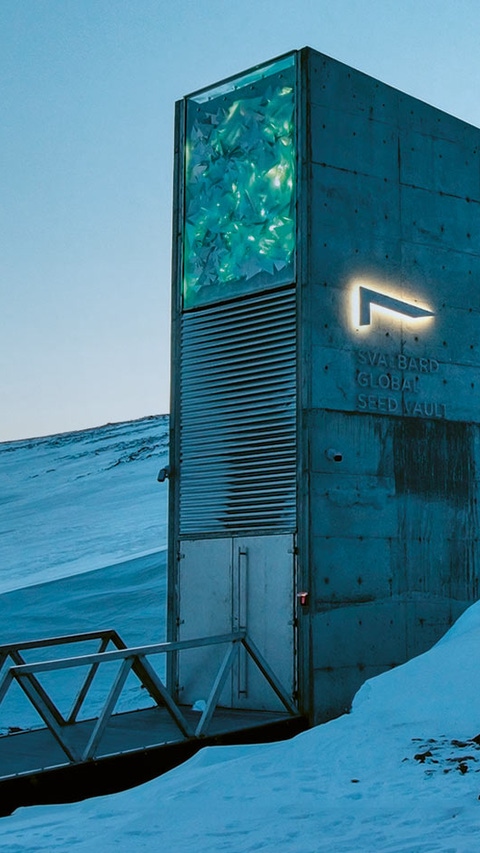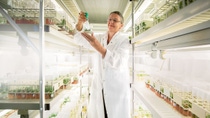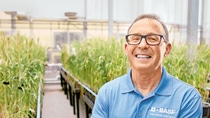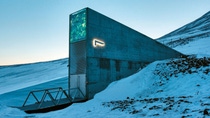Just nine plant species provide
66 percent of the global harvest.
Source: FAO

Old varieties of fruit and vegetables are in vogue. In the case of grain, too, more and more consumers are coming to appreciate the taste and nutritional richness of old varieties. Plant breeders see them as valuable resources for countering problems like climate change.
These cloverleaf-shaped white flowers extending a little cheekily from a short, green stem do look fresh – and yet, the seed of this plant that is thriving in the laboratory of Vienna’s University of Natural Resources and Life Sciences is 32,000 years old. It has survived for millennia in the Siberian permafrost. Researchers from the Russian Academy of Sciences made the plant grow again as a tissue culture in 2012. The team around plant biotechnologist Professor Margit Laimer then applied great skill and diligence to make the campion blossom again in a test tube in 2020. “This is a unique stroke of luck,” Laimer says happily. She now hopes to use genetic analyses to gain insights into how the genetic material in the campion developed – and how plants adapt to changing climatic conditions. This is an important question for research in times of climate change.
The Vienna-based plant biotechnologist Margit Laimer is making the prehistoric Silene stenophylla campion blossom again after 32,000 years.
Back to the origin of things is more than just a slogan for scientists like the researcher Laimer. Human beings seem almost instinctively to seek stability in biological and civilizational roots when faced with increasing threats. Old, almost forgotten plant varieties are experiencing a boom: bakery products made from ancient types of grain, like emmer or einkorn, are selling literally like hotcakes; and fruit and vegetables with a history, like the venerable German Gravenstein apple, are conquering weekly markets in the trendy quarters of major western cities.
The search for something authentic is usually about more than just romantic nostalgia, as old varieties can have tangible benefits for consumers, stresses Mark Sorrells, Professor of Plant Breeding and Genetics at Cornell University in the U.S. state of New York. Especially for people who suffer from the inflammatory celiac bowel disease, bakery products made from einkorn, an ancestor of spelt and wheat, could be more digestible than products based on modern, higher-yield wheat varieties. “These old grain varieties also have a more aromatic flavor,” Sorrells finds. Ten years ago, he launched a regional research project to find out what benefits the use of old varieties could have – not only for farmers and consumers, but also for restaurants and bakeries.
What advantages do old varieties of crops have for consumers and the environment? Mark Sorrells from the United States, a professor of plant breeding, devotes himself with great passion to this question.
“We had to start virtually from scratch,” the geneticist explains. There were hardly any records to indicate which old grain varieties would flourish best in the soil and weather conditions of the Northeastern and Midwestern United States. The only solution: trial and error in the fields, which was often laborious. “When you request seeds from seed banks, you usually receive only three to five grams. This means it takes some time until you have enough seed to test one variety in the field,” he says. Once in the ground, the organically grown, rare varieties suffered from diseases such as loose smut. Ultimately, it turned out that although some of the old new grain varieties could indeed grow without difficulty in their own specific environment, they were of only limited suitability for baking. “Nevertheless, there are some varieties that are worthwhile using commercially, although not on a large scale,” Sorrells says.
This is not simple. The reintroduction of an old variety requires a finely coordinated, local mechanism made up of producers, representatives of the retail and catering sectors, and consumers. One example of this interaction comes from New York State, where plant geneticists and restaurant operators pondered the question of which type of emmer would provide the best bite and flavor for pasta. It is a matter of quality, not quantity, Sorrells stresses, because old grain has a much smaller yield than modern wheat varieties. Often, the stalks are further apart, an individual plant has fewer grains, and these are usually enclosed in a hard, protective shell, the spelt, that is difficult to remove. Farmers, mill operators, bakers and cooks have to be trained in working with old varieties, and restaurateurs need to be schooled in marketing.
But Sorrells’ horizon extends beyond establishing local value chains. “Some of these old varieties have higher concentrations of provitamin A and contain more proteins than modern types,” he says. However, these are precisely the kinds of micronutrients that could be important in the future in combating global malnutrition.
Just nine plant species provide
66 percent of the global harvest.
Source: FAO
“If food based on old varieties makes you feel better and you can afford it, then buy it! But it will not create global food security,” says Chike Mba, Team Leader, Seeds and Plant Genetic Resources at the United Nations Food and Agriculture Organization (FAO). Old seed types are hardly suited to meeting the FAO’s goal of increasing agricultural production by at least 50 percent by 2050, because their yield is too low, he explains. “Biodiversity is important,” Mba says, “but it must not become an end in itself. Nevertheless, it contributes to food security, especially when used as a starting-point for breeding highly developed crop varieties.”
BASF researcher Edward Souza uses the genetic diversity of old varieties to breed modern wheat that is better adapted to cope with climate change.
Professor Edward Souza, Global Head of Wheat Breeding at BASF Agricultural Solutions, sees old varieties as a treasure that needs to be refined. “Our long-term goal is to use them for modern breeding, in order to feed the growing global population and to counter climate change. Therefore, we are systematically testing wild seed types and old varieties from historical collections,” he says. His eyes light up when he talks about the different colors and shapes of historical grain types. “You need to have seen that!” he says. “However,” and here his expression turns serious again, “they are difficult to cultivate.”
The breeding of hybrids, including those with properties of wild varieties, is complicated. Souza draws a picture of a pyramid to illustrate this: From countless varieties with different genetic features, BASF scientists, sometimes in collaboration with external partners, develop new, more effective varieties. In processes that last for years, they breed in desired properties until the apex ultimately contains varieties that combine particular qualities, such as good flavor, improved resistance and optimum yield. What makes hybrid breeding for wheat particularly difficult is that, unlike corn or rye, it is a self pollinator. To prevent the mother line from forming any pollen, Souza and his team use a naturally present genetic sterility for effective cross pollination.
The development of new hybrid wheat seeds like Ideltis™ from BASF involves the interaction of centuries-old routines in breeding with modern genetic analysis methods in the laboratory and computer-based prediction models. Souza and his team still have to test the new hybrids in several consecutive generations in field trials. They then undergo a two-to-three year approval process – as in Germany, for example – before they can be sold. This means both breeding and market introduction are complex processes. Research on Ideltis has been carried out for ten years. By the middle of this decade, it is expected to be available to European and North American growers. In the breeding process, Souza stresses, his team focuses on a variety of wheat-breeding programs, in order to adapt plant properties to local needs. “We use old varieties in the development of hybrid wheat, so as to maximize quality and yield – this is why their preservation is important to us,” he adds.
That is exactly the task carried out in a building rising up out of the expanses of an archipelago in the far north of Norway: the Svalbard Global Seed Vault, a project run by the Global Crop Diversity Trust, the Nordic Genetic Resource Center (NordGen) and the Norwegian government. However, “this building is not a museum,” says Dr. Stefan Schmitz, Executive Director of the trust, even though the concrete structure may look like one at first glance. “Countries around the world deposit seeds from crop plants here as a safety backup.” So far, 1.2 million varieties are stored at the Seed Vault, and their original copies are accessible for use. “Which, facing climate change and the loss of biodiversity, is a ‘life insurance’ for global food security,” Schmitz says.
The Global Seed Vault on Spitzbergen, Norway, started operating in 2008. Seed samples from almost every country in the world are safely stored.
The project is not made up solely of the Seed Vault in Norway, which is something like a backup copy of all the seeds known to humanity. Rather, it is an invisible network of more than 100 regional gene banks – all connected to the headquarters – that extends over the whole Earth. Local breeders in need of seeds send their request to the nearest gene bank. Based on these, they create new varieties by crossing in properties from older seeds, which are then gradually archived again by the seed banks and kept in storage for future generations.
However, Schmitz says, there is a problem: genetic impoverishment. If you breed a plant with a focus on one particular, sought-after property, others will be lost. Schmitz describes the dilemma: “The more selectively bred it is, the less genetically diverse it will be.” To compensate for this genetic erosion, breeders try to re-cross the properties of the distant ancestors of these plants. Schmitz describes this as evolution’s eternal game of cat-and-mouse against pests that become smarter or resistant – but also against a changing climate. In this context, he says, who can know now which genes will be significant for the health and yield of a particular wheat variety in decades to come? This, he adds, is why the widest possible range of genotypes has to be kept alive at a global level, so that the preservation of plants like the prehistoric campion does not remain just a stroke of luck.



